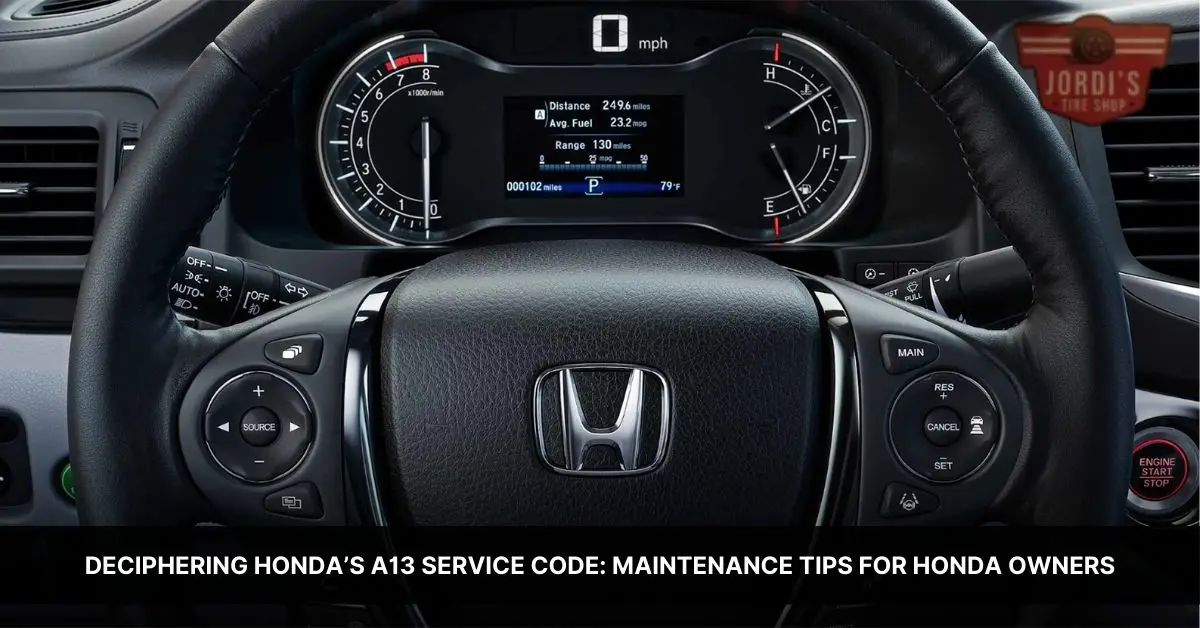Ever seen the A13 service code pop up on your Honda’s dashboard and wondered what it’s all about? You’re not alone. This mysterious code can be a source of confusion for many Honda owners. It’s an integral part of your vehicle’s maintenance minder system, but what does it really mean?
In this text, we’ll demystify the A13 service code, breaking it down into understandable terms. You’ll learn why it’s crucial to your Honda’s health and longevity. So, buckle up and get ready to become an informed Honda owner who knows just what their car needs.
Understanding Honda A13 Service Code

Dive deeper into the functionality of your Honda vehicle as you explore the significance and implications of the A13 service code.
A Brief Overview of Honda Maintenance Codes
Honda’s Maintenance Minder System is a system that carefully monitors your vehicle, with codes designed to signal the need for exact types of maintenance. These maintenance codes pinpoint areas requiring attention, essentially functioning as the primary communication between drivers and their vehicles. With a diverse range of Honda Maintenance codes available, each associated with a different service, understanding these codes becomes crucial to Honda owners.
Decoding the A13 Service Code
A13, specifically, is a vital service code that appears on your Honda dashboard when maintenance is due. The code consists of a letter ‘A’ and numbers ‘1 and ‘3’. ‘A’ refers to the necessity for an oil change, a service needed to maintain your vehicle’s health fundamentally. ‘1’ indicates that the vehicle’s tires need rotation – promoting balanced tire wear and extending your tire lifespan. Finally, ‘3’ symbolises the requirement for transmission fluid replacement, crucial in ensuring the gears in your vehicle are functioning correctly. By recognizing the significance of the A13 service code, Honda drivers can avoid prolonged vehicle damage. Keep your Honda vehicle functioning at its best by becoming adept at these maintenance codes.
Significance of Regular Vehicle Service

Regular Honda servicing, symbolized in codes such as A13, plays a key role in vehicle maintenance. Honda’s Maintenance Minder System, including the A13 service code, outlines necessary maintenance actions to prevent vehicle damage and ensure optimal performance.
Benefits of Regular Honda Service
Sticking to a regular Honda service schedule provides several benefits. Primarily, it extends the lifespan of your Honda, sustaining its efficient performance. Following the designated service codes like A13 allows your vehicle’s oil to be changed, tires to be rotated, and transmission fluid to be replaced at the suggested intervals, effectively preventing potential damage.
A second advantage of regular maintenance is the enhancement of your Honda’s resale value. Vehicles that have a well-documented service history typically have a higher market value. Hence, adhering to the Honda service schedule increases the likelihood of achieving a better resale price when you decide to sell your vehicle.
Finally, regular servicing can also increase your safety on the road. Servicing includes critical checks on the car’s essential components such as brakes, tires and lights. Regular checks of these components can detect potential issues early, reducing the risk of accidents.
Understanding the Impact of Ignoring Service Codes
Neglecting service codes like the A13 can have detrimental impacts on your vehicle and, by extension, your safety. For instance, failing to adhere to an A13 service order means neglecting to change the oil, rotate the tires, or replace the transmission fluid, outlined by the ‘A’, ‘1’, and ‘3’ respectively.
Ignoring oil changes leads to engine damage as the oil becomes less effective at lubricating the engine and absorbing heat. Similarly, neglecting tire rotation can unexpectedly wear the tires out, possibly leading to a blowout while driving. Meanwhile, failing to replace the transmission fluid can cause transmission failure, which is often costly to repair.
In essence, understanding and following the A13 service code, among others, ensures long-term vehicle health, promotes valuable resale, and bolsters safety. Regular understanding and adherence to Honda’s service reminders drive the longevity and optimal performance of your Honda. So, it is critical to pay attention to your vehicle’s service codes and scheduling regular services accordingly.
Unpacking the A13 Service Code
Let’s investigate deeper into the meaning of each component of the A13 service code, elaborating on the specifics for each part: ‘A’, ‘1’, and ‘3’. Each signifies a distinct type of maintenance required for the smooth operation of your Honda vehicle.
The ‘A’ in A13: Oil Change Specifics
“A”, first component of the A13 service code, denotes an oil change. Regular oil changes, according to the Honda owner’s manual, occur every 5,000 to 7,500 miles or at least twice a year for optimal performance. The removal of old engine oil and its replacement with fresh oil not only aids in lubricating engine parts, but also eliminates any dirt particles that could damage the engine.
The ‘1’ in A13: Tire Rotation Explanation
Next, the ‘1’ in A13 service code instructs a tire rotation. It’s recommended to rotate your tires every 7,500 miles, or as indicated by the vehicle’s Maintenance Minder system. Tire rotations ensure even tire wear, extending their lifespan and maintaining your vehicle’s handling and traction. Ignoring this directive can result in uneven tire wear, which makes your ride less smooth and could lead to more frequent tire replacement.
The ‘3’ in A13: Transmission Fluid Changes
Finally, ‘3’ calls for a transmission fluid replacement. Honda suggests swapping out the transmission fluid roughly every 30,000 to 60,000 miles, but this varies depending on driving conditions and driving habits. The proper level and condition of transmission fluid are essential for smooth gear shifting and longevity of the transmission system. Overlooking this procedure means risking damage to the transmission, which can cause costly repairs and impede the vehicle’s performance.
Steps to Perform A13 Service Code Inspection

Getting your Honda vehicle up to code, particularly when the A13 service code flashes up on your dashboard, is a process that encompasses various inspection points. In this text, you’ll find out exactly what your car needs and how to go through the process step by step.
Requirements for the A13 Service Inspection
An A13 Service Inspection involves three primary tasks in the following order: changing your vehicle’s oil (‘A’), rotating the vehicle’s tires (‘1’), and replacing the transmission fluid (‘3’).
Before the inspection begins, there are several necessary prerequisites. First, you’ll need appropriate engine oil, suitable for the exact model of your Honda, to replace the old oil. This element serves as a lubricant for the components of the engine. You’ll also need tools and equipment for tire rotation, providing the even wear that optimizes your vehicle’s handling capabilities. Finally, the requisite transmission fluid is essential for the smooth operation of your car’s transmission system.
Step-by-Step Guide to an A13 Inspection
For a comprehensive A13 inspection, follow the outlined steps. Here, we break down the process into manageable sections, guiding you through it.
- Change the Engine Oil: Begin with running your vehicle’s engine for a few minutes. This action helps to warm up the engine oil, making it easier to drain later. Afterward, locate the oil drain plug under your vehicle, remove it, and allow the old oil to drain into an oil catch pan. Once the oil drains completely, replace the drain plug and proceed to refill the engine with the new oil.
- Rotate the Tires: After the oil change, identify the wear patterns on your vehicle’s tires. Using exact tools, such as a vehicle jack and a wrench, rotate the tires following the rotation pattern recommended by Honda. This process involves moving the tires to different positions on the vehicle to maintain even tire wear and prolong their collective lifespan.
- Replace the Transmission Fluid: To replace the transmission fluid, locate the transmission dipstick and drain plug under the car. Remove the drain plug to allow the old fluid to drain out into a pan. Once emptied, replace the plug and use a funnel to refill the transmission with the new fluid via the dipstick tube.
By meticulously following these steps, you can successfully complete your A13 Service Inspection, optimizing your Honda’s performance and longevity.
Costs Related to A13 Honda Service
After understanding the importance of the A13 service code for Honda cars, exploring into the costs associated with this essential maintenance service is equally vital. Recognizing these costs allows for effective budgeting and preparation, reinforcing the focus on maintaining the optimal health and longevity of your Honda vehicle.
General Pricing Parameters
A Honda A13 service usually ranges between $200 to $300 in most service stations. To begin with, applying the ‘A’ signifying an oil change typically costs anywhere from $30 to $70. For the component signified by ‘1’, which is a tire rotation, you can expect an expense from $20 to $50. Finally, for ‘3’, the transmission fluid replacement, prices tend to hover around $150 to $200. Keep in mind, these prices can vary based on labor costs, the quality and type of materials used, or the exact model of your Honda vehicle.
Additional Cost Factors
Beyond the regular maintenance costs, additional factors can increase the total expenditure. For instance, if you’re behind on your car’s maintenance schedule or if multiple service codes are indicated simultaneously, the costs might climb. More important repairs, such as transmission repairs that might necessitate if you neglect the A13 service code, can be notably expensive, ranging from $1,500 to $3,000. Besides, hourly labor rates differ among service centers, which is yet another variable to consider when assessing the overall costs. Adhering to the A13 maintenance schedule can so help prevent these extra financial burdens, reinforcing its importance for all Honda owners.
When to Seek Professional Help

In some circumstances, getting professional help is the best course of action for addressing the A13 service code on your Honda. This section explains when you might want to consult a professional and how to locate reliable Honda service centers.
Identifying Signs of Major Issues
Watch out for signs of trouble beyond the usual A13 service code. Leaks, rattling, or grinding noises, decreased fuel efficiency, rough gear changes, or any important change in driving feel can signal more serious problems. Engine warning lights – typically indicated by an illuminated “check engine” or “service engine” signal on the dashboard – demand immediate professional attention. Entrust your vehicle to professionals, let them diagnose the situation accurately, efficiently rectify the issue, preventing more severe car troubles down the line.
Finding Reliable Honda Service Centers
Locating a trustworthy service center to handle your Honda’s maintenance ensures the thoroughness of service and extends the lifespan of your vehicle. Seek out centers that specialize in Honda vehicles, have certified Honda technicians, and use genuine Honda parts. Honda’s official website offers a dealer locator tool that helps you find accredited service centers near your location. Peer reviews and ratings on platforms like Yelp can provide additional insights about their service quality. Sticking with trusted professionals supports the optimal functioning of your Honda vehicle, promoting long-term performance and safety.
Conclusion
So there you have it. You’re now fully equipped with the knowledge of Honda’s A13 service code. It’s more than just a random sequence on your dashboard; it’s a crucial part of your vehicle’s maintenance minder system. Remember, ‘A’ signifies an oil change, ‘1’ indicates a tire rotation, and ‘3’ calls for transmission fluid replacement. Regularly adhering to this service schedule not only maintains your Honda’s health but also enhances its longevity, resale value, and safety.
Don’t take these codes lightly. Neglecting the A13 service can lead to costly repairs and diminished performance. Whether you’re performing the tasks yourself or seeking professional help, understanding and following these reminders is key. After all, keeping your vehicle in peak condition is a testament to your commitment to quality and safety. So next time that A13 code pops up, you’ll know exactly what to do. Your Honda will thank you for it.
Q1: What is the A13 service code on a Honda vehicle?
The A13 service code in a Honda vehicle is a vehicle maintenance alert. The ‘A’ indicates that an oil change is necessary, the ‘1’ implies a need for tire rotation, and the ‘3’ suggests that transmission fluid replacement is required. These signals are essential in maintaining vehicle health and performance.
Q2: What are the benefits of regular vehicle servicing?
Regular vehicle servicing extends the vehicle’s lifespan, heightens the resale value, and enhances safety through regular checks of essential components. It also helps prevent potential engine damage, uneven tire wear, and transmission failures.
Q3: What does each component of the A13 service code denote?
In the A13 service code, ‘A’ calls for an engine oil change, ‘1’ recommends a tire rotation, and ‘3’ requires transmission fluid replacement. Respectively, these tasks are recommended every 5,000 to 7,500 miles, 7,500 miles, and 30,000 to 60,000 miles.
Q4: How to carry out an A13 service code inspection?
Performing an A13 service code inspection involves changing the engine oil, rotating the tires, and replacing the transmission fluid. Specific engine oil, tools for tire rotation, and transmission fluid are needed and each step broken down in the article for clarity.
Q5: What is the typical cost associated with the A13 service?
The A13 service typically ranges between $200 and $300, broken down into costs for an oil change ($30 to $70), tire rotation ($20 to $50), and transmission fluid replacement ($150 to $200). Additional services or delayed maintenance could increase the cost.
Q6: How to identify the need for professional help with the A13 service code?
Signs that may necessitate professional help include leaks, unusual noises, or warning lights. Consult a professional for accurate diagnosis and resolution of potential issues. Use Honda’s official website and reviews to find reliable service centers.
Related Posts:
- Deciphering the Honda B137 Service Code: A Guide for Every Honda Owner
- Decoding Honda B123 Service Code: Your Ultimate Guide to Better Vehicle Performance
- Unlocking the Mystery: Your Complete Guide to Honda’s B124 Service Code
- Deciphering Honda’s A13 Service Code: Maintenance Tips for Honda Owners
- Unraveling the Mystery: Your Complete Guide to Acura A13 Service Code
- Decoding the P1D73 Dodge Dart Issue: Comprehensive Guide to Navigate and Fix
- Mastering the C0561 71 Code: Essential Guide for a Smooth, Safe Drive
- Unlocking the Mystery: Understanding & Fixing the ECU 128 Code on Your Freightliner
- Decoding Your Car Dashboard: Unraveling the Fuel System 1 OL Fault Mystery
- Understanding STFT B1 Normal Range: Key to Optimal Vehicle Performance
- Understanding the ‘Service ESC’ Warning on Your Chevy Malibu: Safety, Diagnosis, and Maintenance

